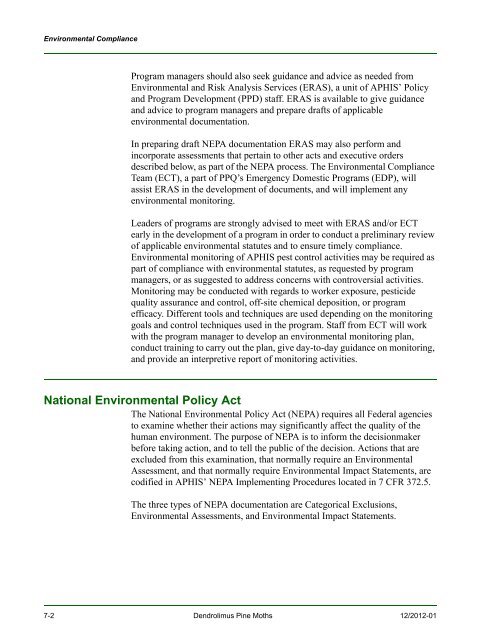New Pest Response Guidelines - aphis - US Department of Agriculture
New Pest Response Guidelines - aphis - US Department of Agriculture
New Pest Response Guidelines - aphis - US Department of Agriculture
You also want an ePaper? Increase the reach of your titles
YUMPU automatically turns print PDFs into web optimized ePapers that Google loves.
Environmental Compliance<br />
Program managers should also seek guidance and advice as needed from<br />
Environmental and Risk Analysis Services (ERAS), a unit <strong>of</strong> APHIS’ Policy<br />
and Program Development (PPD) staff. ERAS is available to give guidance<br />
and advice to program managers and prepare drafts <strong>of</strong> applicable<br />
environmental documentation.<br />
In preparing draft NEPA documentation ERAS may also perform and<br />
incorporate assessments that pertain to other acts and executive orders<br />
described below, as part <strong>of</strong> the NEPA process. The Environmental Compliance<br />
Team (ECT), a part <strong>of</strong> PPQ’s Emergency Domestic Programs (EDP), will<br />
assist ERAS in the development <strong>of</strong> documents, and will implement any<br />
environmental monitoring.<br />
Leaders <strong>of</strong> programs are strongly advised to meet with ERAS and/or ECT<br />
early in the development <strong>of</strong> a program in order to conduct a preliminary review<br />
<strong>of</strong> applicable environmental statutes and to ensure timely compliance.<br />
Environmental monitoring <strong>of</strong> APHIS pest control activities may be required as<br />
part <strong>of</strong> compliance with environmental statutes, as requested by program<br />
managers, or as suggested to address concerns with controversial activities.<br />
Monitoring may be conducted with regards to worker exposure, pesticide<br />
quality assurance and control, <strong>of</strong>f-site chemical deposition, or program<br />
efficacy. Different tools and techniques are used depending on the monitoring<br />
goals and control techniques used in the program. Staff from ECT will work<br />
with the program manager to develop an environmental monitoring plan,<br />
conduct training to carry out the plan, give day-to-day guidance on monitoring,<br />
and provide an interpretive report <strong>of</strong> monitoring activities.<br />
National Environmental Policy Act<br />
The National Environmental Policy Act (NEPA) requires all Federal agencies<br />
to examine whether their actions may significantly affect the quality <strong>of</strong> the<br />
human environment. The purpose <strong>of</strong> NEPA is to inform the decisionmaker<br />
before taking action, and to tell the public <strong>of</strong> the decision. Actions that are<br />
excluded from this examination, that normally require an Environmental<br />
Assessment, and that normally require Environmental Impact Statements, are<br />
codified in APHIS’ NEPA Implementing Procedures located in 7 CFR 372.5.<br />
The three types <strong>of</strong> NEPA documentation are Categorical Exclusions,<br />
Environmental Assessments, and Environmental Impact Statements.<br />
7-2 Dendrolimus Pine Moths 12/2012-01

















